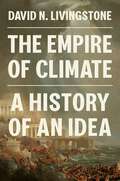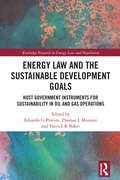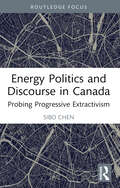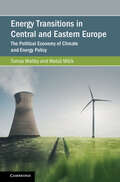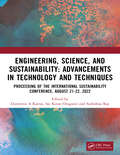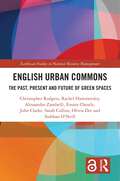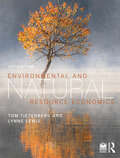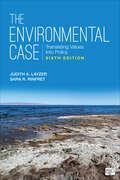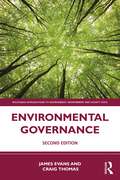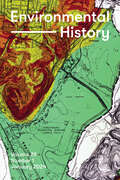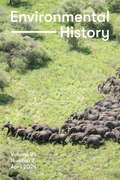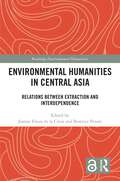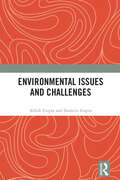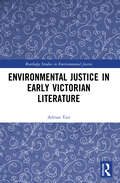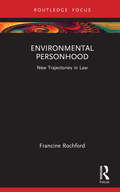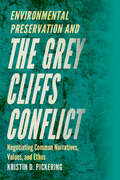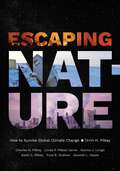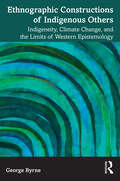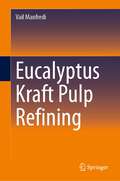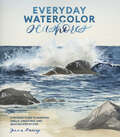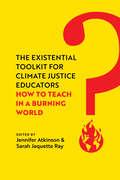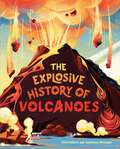- Table View
- List View
The Empire of Climate: A History of an Idea
by David N. LivingstoneHow the specter of climate has been used to explain history since antiquityScientists, journalists, and politicians increasingly tell us that human impacts on climate constitute the single greatest threat facing our planet and may even bring about the extinction of our species. Yet behind these anxieties lies an older, much deeper fear about the power that climate exerts over us. The Empire of Climate traces the history of this idea and its pervasive influence over how we interpret world events and make sense of the human condition, from the rise and fall of ancient civilizations to the afflictions of the modern psyche.Taking readers from the time of Hippocrates to the unfolding crisis of global warming today, David Livingstone reveals how climate has been critically implicated in the politics of imperial control and race relations; been used to explain industrial development, market performance, and economic breakdown; and served as a bellwether for national character and cultural collapse. He examines how climate has been put forward as an explanation for warfare and civil conflict, and how it has been identified as a critical factor in bodily disorders and acute psychosis.A panoramic work of scholarship, The Empire of Climate maps the tangled histories of an idea that has haunted our collective imagination for centuries, shedding critical light on the notion that everything from the wealth of nations to the human mind itself is subject to climate&’s imperial rule.
Energy Law and the Sustainable Development Goals: Host Government Instruments for Sustainability in Oil and Gas Operations (Routledge Research in Energy Law and Regulation)
by Eduardo G Pereira Thomas L Muinzer Patrick R BakerThe UN Sustainable Development Goals are an ambitious agenda for environmental sustainability, economic development, and social transformation. The SDGs include targets for governments, in partnership with private industry and communities, to improve access to affordable and reliable energy, reduce inequality, protect natural resources, and invest in transparent legal institutions and resilient infrastructure. Although transitioning energy systems towards a low-carbon future is a core aspect of the SDGs, the International Energy Agency anticipates that oil and gas will remain a significant component of the global energy mix for some time. Host Government Instruments are tools which governments use to grant oil and gas companies permission to develop state-owned resources. In addition to bringing substantial resources into governments, these HGIs often also include environmental commitments as well as commitments to local hiring, stakeholder engagement, and investment in economic development programmes. The different structures of HGIs and their precise terms and conditions are crucial determinants of the sustainability of oil and gas operations conducted thereunder. This book addresses how governments can use HGIs to advance the SDGs. Part I introduces the SDGs and the legal institutions and governance related to HGIs, including in relation to international energy development, international environmental treaties, the Paris Agreement, and human rights regimes. Part II examines specific provisions within HGIs and regulatory systems which relate to the oil and gas sector and SDGs. It provides case studies to illustrate approaches to HGIs and to identify opportunities for host governments and international oil and gas companies to advance the SDGs. The book concludes with a summary of recommendations regarding how host governments, in partnership with the oil and gas industry, can use HGIs to advance economic development and sustainability goals, and advances potential insights towards development of new and renewable resources.
Energy Politics and Discourse in Canada: Probing Progressive Extractivism (Routledge Focus on Communication Studies)
by Sibo ChenThis book examines the discourse around the intricate economic, political, and ideological struggles underlying Canadian fuel extractivism. Focusing on the two contending discourse coalitions formed by supporters and opponents of British Columbia’s liquefied natural gas (LNC) industry, the book explores the ongoing debates around the issue. The book’s in-depth investigation of the BC LNG controversy identifies progressive extractivism as an increasingly popular policy/discursive paradigm adopted by fossil fuel advocates to legitimize unconventional fossil fuels in an era of intensifying climate crisis. It also highlights the importance of debunking the misleading “jobs versus the environment” dichotomy in mobilizing public opposition to carbon-intensive economic growth. This deeply nuanced look at energy discourse in public policy will have resonance for scholars and students working in the areas of environmental communication, rhetoric, discourse analysis, public policy, and climate change rhetoric.
Energy Transitions in Central and Eastern Europe: The Political Economy of Climate and Energy Policy (Cambridge Studies on Environment, Energy and Natural Resources Governance)
by null Tomas Maltby null Matúš MišíkThis book examines the mutual interplay of climate and energy policies in eleven Central and Eastern European countries in the context of the EU's energy transition. Energy security has long been prioritised in the region and has shaped not only national climate and energy policy, but also EU-level policy-making and implementation. Whilst the region shares economic, institutional and historical energy supplier commonalities it is not homogenous, and the book considers the significant differences between the preferences and policies of these member states. Chapters also explore the effect of the EU on member states that have joined since 2004 and their influence on the EU's energy and climate policies and their role in highlighting the importance of the concepts of security and solidarity. The book highlights the challenges to, and drivers of, energy transitions in the region and compares these with those in global energy transitions.
Engineering, Science, and Sustainability: Advancements in Technology and Techniques
by Dimitrios A Karras Sai Kiran Oruganti Sudeshna RayISC 2022 is dedicated to the Niti Aayog policies to promote sustainability through exchange of ideas emerging out of the academia. The ISC is an annual conference that is held in virtual mode until COVID restrictions on travel exist. The vision of the conference is to capacitate Academia with the necessary ideas that provide insights of the grassroot level development to various stakeholders of the Niti-Aayog policies. Towards this goal, the conference creates a conjunction of various stakeholders of Niti-Aayog policies that include- academic institutions, government bodies, policy makers and industry. The ISC organizers make concerted efforts to promote academic research that would technological, scientific, management & business practices, and insights into policy merits & disruptions. The framework of exchange of ideas is geared towards adoption of deep technologies, fundamental sciences & engineering, energy research, energy policies, advances in medicine & related case studies. This framework enables the round table discussions between the academia, industry and policy makers through its range of plenary and keynote speakers.
English Urban Commons: The Past, Present and Future of Green Spaces (ISSN)
by Christopher Rodgers Rachel Hammersley Alessandro Zambelli Emma Cheatle John Wedgwood Clarke Sarah Collins Olivia Dee Siobhan O’NeillThis book presents a novel examination of urban commons which provides a robust base for education initiatives and future public policy guidance on the protection and use of urban commons as invaluable urban green spaces that offer a diverse cultural and ecological resource for future communities.This book's central argument is that only through a deep understanding of the past and a rigorous engagement with present users can we devise new futures or imaginaries of culture, well-being and diversity for the urban commons. It argues that understanding the genesis of, and interactions between, the different pressures on urban green space has important policy implications for the delivery of nature conservation, recreational access and other land use priorities. The stakeholders in today’s urban commons, whether land users, policy makers or the public, are the inheritors of a complex cultural legacy and must negotiate diverse and sometimes conflicting objectives in their pursuit of a potentially unifying goal: a secure future for our urban commons. This book offers a unique and strongly interdisciplinary study of urban commons, one that brings together original historical investigation, contemporary legal scholarship, extensive oral history research with user groups and research examining the imagined futures for the urban common in modern society. It explores the complex social and political history of the urban common, as well as its legal and cultural status today, using four diverse case studies from within England as exemplars of the distinctively urban common. These are Town Moor in Newcastle, Mousehold Heath in Norwich, Clifton and Durdham Downs in Bristol and Valley Gardens in Brighton. This book concludes by looking forward and considering new tools and methods of negotiation, inclusivity and creativity to inform the future of these case studies, and of urban commons more widely.This book will be of great interest to students and scholars of the commons, green spaces, urban planning, environmental and urban geography, environmental studies and natural resource management.The Open Access version of this book, available at www.taylorfrancis.com, has been made available under a Creative Commons [Attribution-Non Commercial-No Derivatives (CC-BY-NC-ND)] 4.0 license.
Environmental and Natural Resource Economics
by Tom Tietenberg Lynne LewisEnvironmental and Natural Resource Economics is one of the most widely used textbooks for environmental economics and natural resource economics courses, offering a policy-oriented approach and introducing economic theory and empirical work from the field. Students will develop a global perspective of both environmental and natural resource economics and how they interact. This 12th edition provides updated data, new studies, and more international examples. There is a considerable amount of new material, with a deeper focus on climate change and coverage of COVID-19, social justice, and the circular economy. Key features include: Extensive coverage of major contemporary issues including climate change, water and air pollution, resource allocation, biodiversity protection, sustainable development, and environmental justice. Four chapters specifically devoted to climate economics, including chapters on energy, climate mitigation, carbon pricing, and adaptation to climate change. Introductions to the theory and method of environmental economics, including externalities, benefit-cost analysis, valuation methods, and ecosystem goods and services and updates to the social cost of carbon. New examples and debates throughout the text, highlighting global cases and major talking points. Environmental and Natural Resource Economics supports students with end-of-chapter summaries, discussion questions, exercises, and further reading in the book, and the companion website offers additional learning and teaching resources.
The Environmental Case: Translating Values Into Policy
by Judith A. Layzer Sara R. RinfretAnswers to environmental issues are not black and white. Debates around policy are often among those with fundamentally different values, and the way that problems and solutions are defined plays a central role in shaping how those values are translated into policy. The Environmental Case captures the real-world complexity of creating environmental policy, and this much-anticipated Sixth Edition contains 14 carefully constructed cases, including a new study of the Salton Sea crisis. Through her analysis, Sara Rinfret continues the work of Judith Layzer and explores the background, players, contributing factors, and outcomes of each case, and gives readers insight into some of the most interesting and controversial issues in U.S. environmental policymaking.
The Environmental Case: Translating Values Into Policy
by Judith A. Layzer Sara R. RinfretAnswers to environmental issues are not black and white. Debates around policy are often among those with fundamentally different values, and the way that problems and solutions are defined plays a central role in shaping how those values are translated into policy. The Environmental Case captures the real-world complexity of creating environmental policy, and this much-anticipated Sixth Edition contains 14 carefully constructed cases, including a new study of the Salton Sea crisis. Through her analysis, Sara Rinfret continues the work of Judith Layzer and explores the background, players, contributing factors, and outcomes of each case, and gives readers insight into some of the most interesting and controversial issues in U.S. environmental policymaking.
Environmental Governance (Routledge Introductions to Environment: Environment and Society Texts)
by James Evans Craig ThomasClimate change is prompting an unprecedented questioning of the fundamental bases upon which society is founded. Businesses claim that technology can save the environment, while politicians champion the role of international environmental agreements to secure global action. Economists suggest that we should pay developing countries not to destroy their forests, while environmentalists question whether we can solve ecological problems with the same thinking that created them. As the process of steering society, governance has a critical role to play in coordinating these disparate voices and securing collective action to achieve a more sustainable future. Environmental Governance is the only book to discuss the first principles of governance, while also providing a critical overview of the wide-ranging theories and approaches that underpin policy and practice today. It places governance within its wider political context to explore how the environment is controlled, manipulated, regulated and contested by a range of actors and institutions. This book shows how network and market governance have shaped current approaches to environmental issues, while also introducing approaches such as transition management and adaptive governance. In so doing, it highlights the strengths and weaknesses of the different approaches currently in play, and considers their political implications. This second edition has been comprehensively updated to build upon the success of the acclaimed first edition, with a new chapter on the environmental governance of outer space and updated analysis of international climate change summits. It provides a ground-breaking overview of dominant and emerging approaches of environmental governance, forging critical links between them. Each chapter has been updated with new case studies, key debates and figures, and includes questions for discussion and further reading. It is essential reading for students of the environment, politics and sociology, and, indeed, anyone concerned with changing society to secure a more sustainable future.
Environmental History, volume 29 number 1 (January 2024)
by Environmental HistoryThis is volume 29 issue 1 of Environmental History. Environmental History (EH) is the world’s leading scholarly journal in environmental history and the journal of record in the field. Scholarship published in EH explores the changing relationships between humans and the environment over time. This interdisciplinary journal brings together insights from geography, anthropology, the natural sciences, and many other disciplines to inform historical scholarship.
Environmental History, volume 29 number 2 (April 2024)
by Environmental HistoryThis is volume 29 issue 2 of Environmental History. Environmental History (EH) is the world’s leading scholarly journal in environmental history and the journal of record in the field. Scholarship published in EH explores the changing relationships between humans and the environment over time. This interdisciplinary journal brings together insights from geography, anthropology, the natural sciences, and many other disciplines to inform historical scholarship.
Environmental Humanities in Central Asia: Relations Between Extraction and Interdependence (Routledge Environmental Humanities)
by Jeanne Féaux de la CroixThis book is the first collection to showcase the flourishing field of environmental humanities in Central Asia. A region larger than Europe, Central Asia possesses an astounding range of environments, from deserts to glaciated peaks. The volume brings into conversation scholarship from history to social anthropology, demonstrating the contribution that interdisciplinary and engaged research offers to many urgent issues in the region: from the history of conservationism to the tactics of environmental movements, from literary engagements with ‘pure nature’ to the impact of fossil fuel extraction. The collection focuses on the Central Asian republics of the former USSR, where a complex layering of nomadic and sedentary, Turkic and Persianate, Islamic and Soviet cultures ends up affecting human relations with distinct environments. Featuring state-of-the-art contributions, the book enquires into human-environment relations through a broad-brush typology of interactive modes: to extract, protect, enspirit and fear. Broadening the scope of analysis beyond a consideration of power, the authors bring into focus alternative local cosmologies and the unintended consequences of environmental policy. The volume highlights scholarship from within Central Asia as well as expertise elsewhere, offering readers diverse modes of knowledge-production in the environmental humanities. This book is an important resource for researchers and students of the environmental humanities, sustainability, history, politics, anthropology and geography of Asia, as well as Soviet and Post-Soviet studies.
Environmental Issues and Challenges
by Abhik Gupta Susmita GuptaThis book explores the field of environmental studies emphasizing its multidisciplinary nature. It looks at the fundamentals of environmental conservation and the management of sensitive ecosystems. The book provides an overview of the basic concepts used to understand and study diverse ecosystems and their functions as well as the progressively larger yet mutually inclusive units, such as the landscape and the biome. It examines the challenges towards preserving biodiversity which is under severe threat due to climate change, exploitation of natural resources, pollution, and man-made disasters. Besides outlining the causes and effects, the authors outline control mechanisms to keep pollution within safe limits and offer suggestions for resolving issues such as wildlife poaching and trade, water and air pollution, deforestation, and biodiversity loss through policy changes. This book will be of interest to the students, researchers, teachers of environmental studies, environmental science, sociology, political science, and public administration. This book will also be useful to environmentalists, wildlife conservationists, and policy makers.
Environmental Issues and Challenges
by Abhik Gupta Susmita GuptaThis book explores the field of environmental studies emphasizing its multidisciplinary nature. It looks at the fundamentals of environmental conservation and the management of sensitive ecosystems.The book provides an overview of the basic concepts used to understand and study diverse ecosystems and their functions as well as the progressively larger yet mutually inclusive units, such as the landscape and the biome. It examines the challenges towards preserving biodiversity which is under severe threat due to climate change, exploitation of natural resources, pollution, and man-made disasters. Besides outlining the causes and effects, the authors outline control mechanisms to keep pollution within safe limits and offer suggestions for resolving issues such as wildlife poaching and trade, water and air pollution, deforestation, and biodiversity loss through policy changes.This book will be of interest to the students, researchers, teachers of environmental studies, environmental science, sociology, political science, and public administration. This book will also be useful to environmentalists, wildlife conservationists, and policy makers.
Environmental Justice in Early Victorian Literature (Routledge Studies in Environmental Justice)
by Adrian TaitThis innovative new book combines environmental justice scholarship with a material ecocriticism to explore the way in which early Victorian literature (1837–1860) responded to the growing problem of environmental injustice. As this book emphasises, environmental injustice – simply, the convergence of poverty and pollution – was not an isolated phenomenon, but a structural form of inequality; a product of industrial modernity’s radical reformation of British society, it particularly affected the working classes. As each chapter reveals in detail, this form of environmental inequality (or ‘classism’) drew sharply critical reactions from figures as diverse as Thomas Carlyle, Friedrich Engels, Charles Dickens, and John Ruskin, and from within the Chartist movement, as working-class writers themselves reacted to the hazardous realities of a divided society. But as this book also reveals, these writers recognised that a truly just society respects the needs of the nonhuman and takes account of the material world in all its own aliveness; even if only tentatively, they reached for a more inclusive, emergent form of justice that might address the social and ecological impacts of industrial modernity, an idea which is no less relevant today. This book represents an indispensable resource for scholars and students working in the fields of Victorian literature, environmental justice, and ecocriticism.
Environmental Personhood: New Trajectories in Law (New Trajectories in Law)
by Francine RochfordThis book examines the increasingly widespread movement to recognise the environment as a legal person. Several countries have now recognized that nature, or parts of nature, have juristic personhood. In this book, the concept of legal personhood and its incidents are interrogated with a view to determining whether this is, or could be, a positive contribution to modern environmental problems. Surveying historical and current positions on the juristic concept of legal personhood, the book engages recent legislation and case law, in order to consider the attempt in several countries to vest personhood in rivers, river basins and ecosystems. Comparing approaches in a range of countries – including New Zealand, India, Ecuador, the United States and Australia, it addresses the methods employed, the purported aims, the mechanisms for enforcement, and the entrenchment of legal protections. Throughout, the book elicits the difficult relationship between an historically anthropocentric idea of personhood and its extension beyond the human; concluding that the attribution of personhood to the environment is an important, but limited, contribution to environmental sustainability. Accessibly written, this book will appeal to scholars, students and others with interests in environmental law, environmental science and public policy, and ecology more generally.
Environmental Preservation and the Grey Cliffs Conflict: Negotiating Common Narratives, Values, and Ethos
by Kristin D. PickeringBased on a qualitative, ethnographic, observational case study approach, Environmental Preservation and the Grey Cliffs Conflictpresents an analysis of the conflict negotiation between the U.S. Army Corps of Engineers and a local community that struggled to address a deteriorating Corps-managed recreational lake area in Tennessee known as “Grey Cliffs.” Viewing the dispute from the perspective of a new member of the community and a specialist in technical communication and professional writing, Kristin Pickering provides a unique perspective on this communication process. Though environmental degradation and unauthorized use threatened the Grey Cliffs recreational lake area to the point that the Corps considered closure, community members valued it highly and wanted to keep it open. The community near this damaged and crime-ridden area needed help rejuvenating its landscape and image, but the Corps and community were sharply divided on how to maintain this beloved geographic space because of the stakeholders’ different cultural backgrounds and values, as well as the narratives used to discuss them. By co-constructing and aligning narratives, values, and ethos over time—a difficult and lengthy process—the Corps and community succeeded, and Grey Cliffs remains open to all. Focusing on field notes, participant interviews, and analysis of various texts created throughout the conflict, Pickering applies rhetorical analysis and a grounded theory approach to regulation, identity, sustainability, and community values to analyze this communication process. Illustrating the positive change that can occur when governmental organizations and rural communities work together to construct shared values and engage in a rhetoric of relationship that preserves the environment, Environmental Preservation and the Grey Cliffs Conflict provides key recommendations for resolving environmental conflicts within local communities, especially for those working in technical and professional communication, organizational communication, environmental science, and public policy.
Escaping Nature: How to Survive Global Climate Change
by Orrin H. Pilkey Charles O. Pilkey Linda P. Pilkey-Jarvis Norma J. Longo Keith C. Pilkey Fred B. Dodson Hannah L. HayesIndustrial and agricultural greenhouse gas emissions are rapidly warming Earth’s climate, unleashing rising seas, ocean acidification, melting permafrost, powerful storms, wildfires, floods, deadly heat waves, droughts, tsunamis, food shortages, and armed conflict over shrinking water supplies while reducing nutritional levels in crops. Billions of people will become climate refugees. Hotter temperatures will allow tropical diseases to spread into temperate regions. Higher levels of CO2, allergens, dust, and other particulate matter will impair our physical and mental health and even reduce our cognitive abilities. Climate change disproportionately affects the world’s poor. It also harms Nature, and could ultimately trigger a sixth mass extinction. In Escaping Nature, Orrin H. Pilkey and his coauthors offer concrete suggestions for how to respond to the threats posed by global climate change. They argue that while we wait for the world’s governments to get serious about mitigating climate change we can adapt to a hotter world through technological innovations, behavioral changes, nature-based solutions, political changes, and education.
The Essential Guide to Wood Pallet Projects: 40 DIY Designs—Stunning Ideas for Furniture, Decor, and More
by Samantha Hartman Danny DarkeRustic meets modern with this charming do-it-yourself guide. Here are 40 easy-to-follow designs, ranging from coffee tables and wine racks to decorative wall art, all with step-by-step and clear full-color photographs. Perfect for those looking for simple and creative ways to decorate their homes. Wooden shipping pallets have found an unlikely second life: beautiful, handcrafted home décor without the designer price. The DIY market has long been drawn to refurbishing furniture and interior design on a budget, but easily accessible wood pallets have opened up all-new and inspiring ways to personalize a home in an eco-friendly, low-cost way. Beginner and veteran DIYers alike can take delight in crafting various furniture and décor that will impress and inspire without breaking the bank. Included within are instructions on how to make the following projects: Hanging ShelfDeck ChairWall-Hanging Mason Jar OrganizerPallet-Mounted Bottle OpenerWall-Mounted Coat RackSconcesDoor Handle Serving TrayPallet Arrow Wall ArtOutdoor Flower BoxFlower Arrangement CenterpieceClothes Pin Picture FrameRustic NightstandShabby Chic ToolboxFarmhouse Spice RackFarmhouse Wall ClockTealight Candle HoldersAnd more! With wooden pallets, the scope of the project is boundless, and warehouses and stores are happy to give them away for free. What was once a scavenger hunt and test of skill for experienced DIYers can now be an easy weekend project for even the newest of crafters. Take pride in creating imaginative home stylings with found and reclaimed materials that will help the environment, save you money, and make your home even more lovely!
Ethnographic Constructions of Indigenous Others: Indigeneity, Climate Change, and the Limits of Western Epistemology
by George ByrneThis book examines the ways in which indigeneity interacts with climate change politics at multiple levels and at the same time offers a self-critical reflection on the role of ethnographic research (and researchers) in this process. Through a multi-sited ethnography, it shows how indigeneity and climate change mitigation are at this point so intensely intertwined that one cannot be clearly understood without considering the other. While indigenous identities have been (re)defined in relation to climate change, it argues that Indigenous Peoples continue to subvert pervasive notions of the nature/culture dichotomy and disrupt our understanding of what it means to be human in relation to nature. It encourages students and researchers in anthropology, international development, and other related fields to engage in more meaningful reflection on the epistemic shortcomings of “the West”, including in our own research, and to acknowledge the ongoing role of power, coloniality, extractivism, and whiteness in climate change discourses.
Eucalyptus Kraft Pulp Refining
by Vail ManfrediThis book presents a brief history of papermaking followed by comments regarding wood as a source of fibers, including its chemical and anatomical characteristics and the influence of these aspects on the quality of the pulp produced. In addition, the author describes the effects of the pulping process, mainly a chemical process, on pulp quality and how these wood characteristics influence both the refining process as the quality of the final paper. The book further provides a broad discussion, based on experimental results, on the contribution of the main operating refining variables and the main strategies that can be used industrially to optimize the operating results. From this evaluation, the parameter that complements the specific edge load theory is identified. This parameter is related to the retention time of the fiber flocs inside the refiner.
Everyday Watercolor Seashores: A Modern Guide to Painting Shells, Creatures, and Beaches Step by Step
by Jenna RaineyFrom the Instagram artist behind Everyday Watercolor comes a beautiful step-by-step guide to painting shells, sea creatures, and oceanscapes in her effortlessly modern style.Jenna Rainey shares a gorgeously illustrated guide to painting a wide range of ocean-inspired subjects, from starfish and whales to beach landscapes and cresting waves. Featuring step-by-step instructions easy enough for beginners and inspiring for hobbyists, Rainey's fresh, contemporary illustrations bring more than thirty-five fishes, shells, sea creatures, corals, beaches, and ocean scenes to life. Everyday Watercolor Seashores is an accessible muse for the next generation of watercolor artists, creatives, and nature lovers alike.
The Existential Toolkit for Climate Justice Educators: How to Teach in a Burning World
by Jennifer Atkinson Sarah Jaquette RayAn easy-to-use field guide for teaching on climate injustice and building resilience in your students—and yourself—in an age of crisis. As feelings of eco-grief and climate anxiety grow, educators are grappling with how to help students learn about the violent systems causing climate change while simultaneously navigating the emotions this knowledge elicits. This book provides resources for developing emotional and existential tenacity in college classrooms so that students can stay engaged. Featuring insights from scholars, educators, activists, artists, game designers, and others who are integrating emotional wisdom into climate justice education, this user-friendly guide offers a robust menu of interdisciplinary, plug-and-play teaching strategies, lesson plans, and activities to support student transformation and build resilience. The book also includes reflections from students who have taken classes that incorporate their emotions in the curricula. Galvanizing and practical, The Existential Toolkit for Climate Justice Educators will equip both educators and their students with tools for advancing climate justice.
The Explosive History of Volcanoes
by Clive GiffordSpewing out fountains of red-hot lava and toxic plumes of smoke, volcanoes are dangerous and deadly. But every volcano is different - in shape and size, location and destructiveness.The Explosive History of Volcanoes explains the Volcanic Explosivity Index giving examples of more than 25 of the most, and least, explosive volcanoes in history and in the world today.Find out about these amazing natural phenomena and see how they're formed, where they are in the world and why some explode so violently. Discover why people live so close to volcanoes and how scientists are helping to predict when the next eruptions might occur.The consultant, Professor Katharine Cashman, is Professor of Volcanology, currently working at the University of Oregon.
